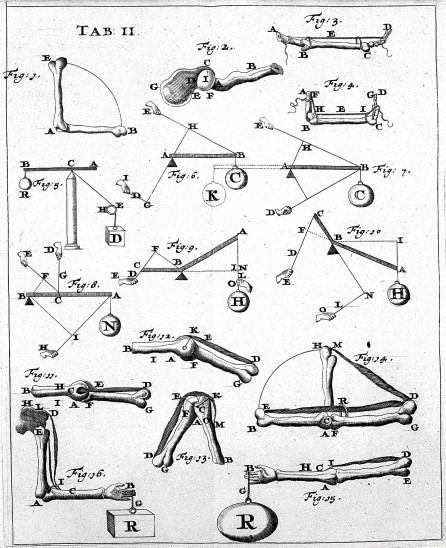 | ||
Iatrophysics or iatromechanics (fr. Greek) is the medical application of physics. It provides an explanation for medical practices with mechanical principles. It was a school of medicine in the seventeenth century which attempted to explain physiological phenomena in mechanical terms. Believers of iatromechanics thought that physiological phenomena of the human body followed the laws of physics. It was related to iatrochemistry and was particularly associated with the work of Giovanni Borelli, who modeled the human body, various animals, and their motions using mechanical principles.
Contents
Particles
A key component of iatrophysical anatomy was the study of particles. This was particularly influenced by 17th century developments in microbiology, the most prominent being the microscope. Anton von Leeuwenhoeck was a Dutch scientist who is known for his use of the microscope for identifying single-celled organisms. He was also the first to observe muscle fibers, bacteria, spermatozoa and blood flow in capillaries. Another famous figure in microbiology at the time was Robert Hooke, an English scientist most famous for his use of the microscope for the discovery of cells. In his most famous work, Micrographia (1665), he attributed “occult properties” as elementary “contrivances of nature”. Like Galileo, he shared an iatrophysical viewpoint and saw living organisms as groups of small machines. The development of the microscope was largely influential in this view.
Iatrophysicists
One of the most influential iatrophysicists was Hermann Boerhaave (1668-1738), a Dutch physician and chemist at the University of Leiden. Like other iatrophysicists, he viewed physiology as a mechanism. While he disagreed with the idea that the body and the mind were connected, he attributed everything related to the body to extension, impenetrability, or motion.
Francis Glisson (1597-1677) was known for his work on circulation of the blood, the mechanisms of the nervous system, and hereditary diseases. He was largely influenced by Harvey’s work on the sentient nature of blood and his work demonstrates iatrophysical ideology particularly through his views of attraction and irritability, or the concept of how the body fibers react to irritation. In his work, Anatomia hepatis, he argues that branches cross, and carried blood is separated in the liver. This in turn is sucked up by biliary vessels through an attraction that Glisson attributes as similar, magnetic, or natural.
Albrecht von Haller (1708-1777) was another prominent iatrophysicist, who like Glisson, focused on physiology as mechanisms of body fibers. He shared Glisson’s views on irritability, but unlike Glisson, attributed the reaction to external stimuli solely to body fibers, and not in the inherent power of matter as Glisson had suggested. In his work Physiologiae Corporis Humani (1757–1766), he described organs and muscles of the body as interwoven fibers. His viewpoints on muscles were that they had a contractile tendency which he termed vis mortua, or dead power. He attributed this muscle contraction to irritability, which he described as being an inherent power. He particularly made the distinction between irritability and sensibility, irritability being the power of muscular contraction and sensibility being nerve impulse. Therefore, a part was irritable if it contracted upon contact, and sensible if the contact impacted the mind.
Relationship with Iatrochemistry
Similar to iatrophysics, iatrochemistry was a school of thought that related medicine and anatomy instead to chemistry, instead of mechanics. Iatrophysics and iatrochemistry were closely related. Many prominent iatrophysicists such as Borelli and Descartes utilized chemistry in order to explain physiological processes. Particularly, Franciscus de la Boë was an adamant believer in chemical processes as an explanation for the body. He emphasized fermentation and effervescence for the input of chemistry and circulation into physiology.
Influence on Medicine
In the Middle Ages, Galenic anatomo-physiology prevailed as the leading medical thought. Furthermore, Aristotelian natural philosophy had dominated for centuries, including the humoral system as a primary method of medical thought. However, the philosophies of Aristotle, Hippocrates, and Galen began to wane in popularity, replaced by anatomical and philosophical schools of thought based on mechanics and chemical naturalism. Ideologies such as iatrophysics and iatrochemistry began to prevail. The decline of Galenic philosophy-based medicine coupled with the rise of new ideologies was spurred by the advent of new discoveries in anatomy and physiology, such as that of William Harvey’s (1578-1657) work centered on circulation of the blood. His idea that pulse, respiration, and nutrition were all working components of a unified system revolutionized preexisting ideas about blood, nutrition, and heat. The discovery of the circulation of the blood was crucial in the development of iatrophysics in that it was the first that related “circulations” to physiological functions. This led to the advent of new discoveries such as the circulation of nutritive fluid, circulation of lymph, and circulation of nervous juice, all of which relate a machine-like mechanism to anatomy.
Traditionally, physiological functions were believed to be regulated by purposeful tendencies. However, the advent of the new medicinal schools of thought transformed the way physiology was approached. Secretion and excretion were no longer due to attractive tendencies, the function of the lungs were now due to the mixing of different parts of the blood, digestion was seen as a process of grinding and mincing, and health and disease were associated with movement, obstruction, and stagnation of the various bodily fluids running through the body. The body increasingly became viewed as a function of a machine, especially with the development of Isaac Newton’s theory of gravitation and motion. Newtonian physics came to widely influence the way the body was viewed, and physiology was increasingly focused on a clockwork mechanism, and the later hydraulics was even applied to the movement of bodily fluids. Furthermore, with the publication of Newton’s Opticks in 1704, physiologists increasingly depended on the notions of ether and effluvia in their anatomical observations.
